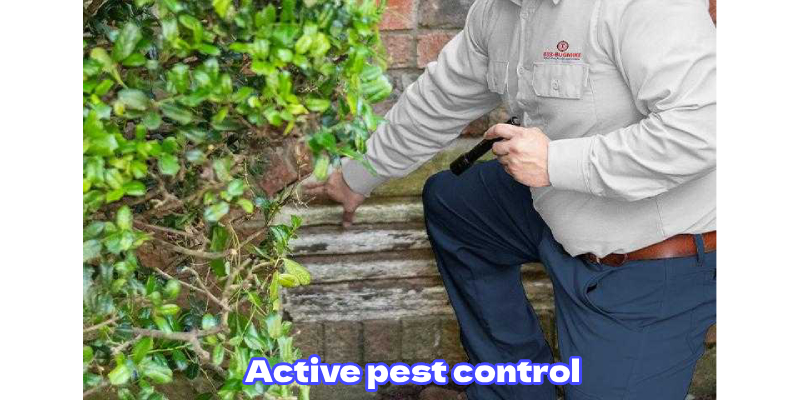Active pest control more than just a simple approach to the problem, Active Pest Control marks an important step forward in protecting the environment and maintaining ecological balance. Join gtrinformation.com to learn about the advantages and challenges of this approach, and how it contributes to shaping our quality of life.
What is active pest control?
Active Pest Control” is a concept that refers to measures and methods used to control and prevent the growth of pests and species that are harmful to agriculture, the living environment, and human health. Article This may include the use of chemical, physical, or biological methods to prevent the growth and spread of pests.
“Active Pest Control” measures often place the focus on preventing pest growth through means such as using pesticides, mechanical devices, installing obstacles, or even using Using useful microorganisms to control pests without harming the environment and humans.
The goal of Active Pest Control is to minimize damage caused by pests, maintain ecological balance, protect agriculture and crops, and keep the human environment safe and healthy.

Some important implications of pest control
Protecting Agriculture
Protecting Crops
Pests can cause great damage to crops and orchards, affecting yield and quality.
Forest protection
Pests can also harm forests and cause severe damage to the forest ecosystem.
Protecting the Living Environment
Protection of Wild Animals and Plants
Uncontrolled pest proliferation can affect wild animals and plants and change the natural ecological balance.
Maintaining Biodiversity
Pest control helps maintain biodiversity in the environment, important for the stability of ecosystems.
Protecting Human Health
Prevention of Infectious Diseases
Some pests can be vectors for diseases such as dengue fever, encephalitis, and parasitic infections.
Reduces the Risk of Allergies
Some pests can cause allergies and other health problems in humans.
Asset and Economic Protection
Protecting Warehouses and Storage Places
The presence of pests can harm property and stored goods.
Infrastructure Protection
Pests like termites can pose a risk to infrastructure, such as construction sites.

Advantages of Active Pest Control
High Efficiency
Active Pest Control is often highly effective in controlling pests, minimizing damage to agriculture, habitat and property.
Environmental protection
Compared to some chemical pest control methods, Active Pest Control often aims to use physical or biological means, minimizing negative impacts on the environment and natural ecosystems.
Safe for Human Health
Prioritizing the use of biological methods and physical means reduces the risk of toxicity to human health, especially compared to the use of strong chemical pesticides.
Maintaining Ecological Balance
Active Pest Control often focuses on maintaining ecological balance by properly controlling pests, helping to reduce the risk of disrupting the food chain and affecting biodiversity.
Reduce Total Costs
Although there may be a higher initial cost for some methods, Active Pest Control typically reduces total costs over time due to its long lasting effectiveness and reduced need for large doses of chemicals. .
More Prevention
Active Pest Control methods are more frequent and proactive in preventing the occurrence of pests, helping to stop the problem before it becomes too large and difficult to control.
Reduce the Risk of Drug Resistance
The use of a variety of methods in Active Pest Control reduces the risk of developing resistance in pests, a common problem when using only one chemical.

Challenges and limitations
Possibility of Developing Drug Resistance
Using a variety of methods can reduce the risk of insecticide resistance. However, if not managed carefully, resistance can develop, reducing the effectiveness of control methods.
Effects on the Biosphere
Control measures, even biological ones, can also affect some other biosphere species, especially microorganisms and other space species.
Toxic Risk to Animals and Plants Other than Pests
Although potentially safe for humans, some control methods can have toxic effects on animals and plants other than pests, especially when chemicals are used.
Alternative Plants and Animals
Some control methods can alter the distribution of animals and plants, allowing species other than pests to increase, possibly leading to new problems.
Wild Animals and Plants May Be Impacted
Control measures can impact wild plants and animals, especially if they are rare or endangered species.
Need Community Proactivity
To ensure the effectiveness of Active Pest Control, cooperation and initiative from the community are needed, both in education and in implementing control measures.
High Initial Cost
Some control methods, especially high-tech ones, may require higher initial costs than some more traditional methods.
Effectiveness May Depend on Specific Environment
The effectiveness of Active Pest Control can depend heavily on specific environmental conditions, such as weather, terrain, and the type of pest being controlled.
In conclusion
Active Pest Control is not just a method of pest control, but an embodiment of respect for the environment and a desire to build a responsible global community. Let’s continue to support and promote these solutions, so that together we can protect the planet and overcome the challenges of the future.